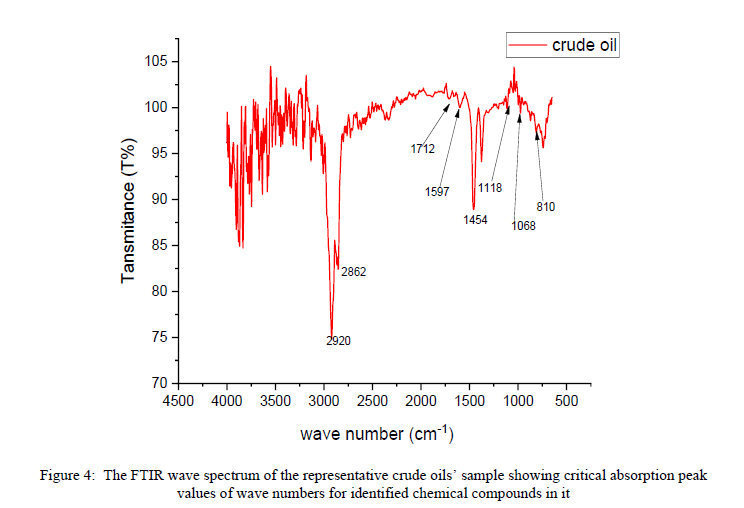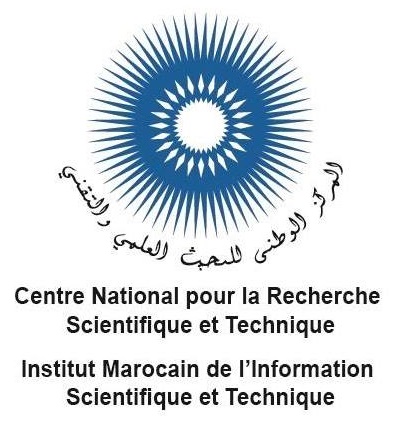X-ray Diffraction and Fourier Transform Analysis of Corrosive Components of Crude Oils Used by Kaduna Refinery for Corrosion Control
Keywords:
Crude oils, Corrosivity, Kaduna refinery, Variables, Strategic informationAbstract
Kaduna refinery is a critical segment of the Nigerian economy but is subject to costly corrosion problems. The refinery obtains crude oils from various sources and processes them under peculiar conditions into essential chemical products. This research was undertaken in order to gain insight into the component proportions of the refinery’s employed crude oils that contribute to corrosion problems. The component proportions of a homogeneous admixture of the employed crudes at the refinery were analyzed using XRD and FTIR techniques. Obtained results and analysis indicate that crude oils employed at the refinery are generally significantly corrosive to most materials due to their appreciable total component contents of sulfur, carbon, idrialite, refikite, flagstaffite, and silicon dioxide up to 35%, which can be corrosive per se or can undergo reactions, especially at higher refining temperatures, to produce abundant quantities of corrosion agents that include acids, chlorides, water, carbon dioxide, hydrogen sulfide, etc.
Downloads
References
S. Aluvihara and J. K. Premachandra, “Fundamental Corrosive Properties of Crude Oils and their Effect on the Ferrous Metals’’, Journal of Chemical Engineering and Process Technology, vol 9(4), 2018, pp. 1-7, DOI: 10.4172/2157-7048.1000390
M. Yari, “The 6 Corrosive Components that can be found in Crude Oil, 2020’’. Available online at https://www.corrosionpedia.com/the-6-corrosive-components-that-can-be-found-in-crude-oil/2/1424. Accessed, 27th December. 2022.
A. H. Al-Moubaraki, I. B. Obot, “Corrosion Challenges in Petroleum Refinery Operations: Sources, Mechanisms, Mitigation, and Future Outlook’’, Journal of Saudi Chemical Society, vol 25(12), pp. 1-28, 2021, https://doi.org/10.1016/j.jscs.2021.101370.
T.N. Guma. and E.O. Ajayi, “Corrosion Management and Control in the Petroleum Industry: A Case Study of the Kaduna Refinery’’, IOSR Journal of Mechanical and Civil Engineering, vol 15(4), pp. 6–11, 2018.
I. Ahmad, S.M. Sohail., H. Khan., R. Khan and W. Ahmad, “Characterization of Petroleum Crude Oils by Fourier transform infrared (FT-IR) and gas chromatography-mass spectrometry’’, Petroleum & Petrochemical Engineering Journal, vol 2(2), 2018, pp. 1-7, DOI - 10.23880/PPEJ-16000148.
T.N. Guma, E.O. Ajayi and M.H. Mohammed, “Standard Techniques of Stress Corrosion Cracking Testing: A Review’’, Journal of New views in Engineering and Technology (JNET), vol 2(1), 2020, pp. 58-72.
A. Fadlelmoula., D. Pinho., V.H. Carvalho., S.O. Catarino., G. Minas. “Fourier Transform Infrared (FTIR) Spectroscopy to Analyze Human Blood over the Last 20 Years: A Review towards Lab-on-a-Chip Devices’’, Micromachines (Basel), 13(2), 2022, Doi: 10.3390/mi13020187. PMID: 35208311; PMCID: PMC8879834.
J. Xia., Y. Xiong., S. Min., and J. Li. “A Review of Recent Infrared Spectroscopy Research for Paper’’, Applied Spectroscopy Reviews, pp. 1-17, 2022.
https://doi.org/10.1080/05704928.2022.2142939
InnovaTech. “How does FTIR Works, 2023’’, Available Online at:
https://www.innovatechlabs.com/newsroom/672/stuff-works-ftir-analysis/, Accessed 13th February, 2023.
L., Hamoudi-Belarbi., H. Safia., B. Khaled., I. Nouri., B. Leila., and K. Mohamed, “Bioremediation of Polluted Soil Sites with Crude Oil Hydrocarbons Using Carrot Peel Waste’’, Environments, vol 5, pp.124-135, 2018, DOI - 10.3390/environments511012
J. Xiao, Y. Song, Y. Li, “Comparison of Quantitative X-ray Diffraction Mineral Analysis
Methods’’. Minerals, vol 13(4), pp. 1- 15, 2023, https://doi.org/10.3390/min13040566
G. Muktadir., M. Amro., N. Kummer., C. Freese., and K. Abid. “Application of X-ray Diffraction (XRD) and Rock–Eval Analysis for the Evaluation of Middle Eastern Petroleum Source Rock. Energies’’, vol 14(20), pp. 66-72, 2021, https:// doi. 10.3390/en14206672
T.N. Guma and Abubakar, A.A, “Analysis of Steel-Corrosive Chemical Species in Nigerian Defence Academy Soil in Kaduna Metropolis Using X-Ray Fluorescence and Diffraction Techniques’’, Uniport Journal of Engineering and Scientific Research (UJESR), vol 5, pp. 139–146, 2020.
M.A. Fahim., T.A. Alsahhaf and A. Elkilani, “Fundamentals of Petroleum Refining’’, Chemical, Petrochemical and Process, vol 2010, pp. 1-487, 2010.
M.A. Azam., N.E. Safie and H.H. Hamdan, “Effect of Sulfur Content in the Crude Oil to the Corrosion Behavior of Internal Surface of API 5L X65 Petroleum Pipeline Steel’’, Manufacturing Technology, vol 21(5), pp. 1-19, 2021.
R. Pažout., J. Sejkora., J. Maixner., M. Dušek., & J. Tvrdý, “Refikite from Krásno, Czech Republic: A crystal-and molecular-structure study’’. Mineralogical Magazine, vol 79(1), pp. 59-70, 2015, Doi:10.1180/minmag.2015.079.1.06.
M.S. Bhatti, “Why Silica in Water is Important to Measure’’, LinkedIn, July 18, 2022. Available online at https://www.linkedin.com/pulse/why-silica-water-important-measure-manmeet-singh-bhatti?trk=pulse-article_more-articles_related-content-card, Accessed on March 17, 2023.
H. Devianto, M. Eviani, R. A. Rahardi, F. Yusupandi, “The Effect of Total Sulfur Content and Total Acid Number (TAN) on Small Scale Oil Refinery’’, IOP Conference: Materials Science and Engineering, vol 543, pp. 1-12, 2019, 012027, doi:10.1088/1757-899X/543/1/012027
L. Khaksar and J. Shirokoff, “Effect of Elemental Sulfur and Sulfide on the Corrosion Behavior of Cr-Mo Low Alloy Steel for Tubing and Tubular Components in Oil and Gas Industry’’, Materials (Basel), vol 10(4), 430, 2017, Doi: 10.3390/ma10040430
G.M. Bota., D. Qu., S. Nesic., and H.A. Wolf. “Naphthenic Acid Corrosion of Mild steel in the Presence of Sulfide Scales Formed in Crude Oil Fractions at High Temperature’’, NACE International Corrosion Conference and Expo, 14-18 March, 2010, San Antonio, Texas, USA.
Q. Xin and H.D. Dettman. “Corrosivity Study of Sulfur Compounds and Naphthenic Acids Number under Refinery Conditions’’, Paper presented at the CORROSION 2016, Vancouver, British Columbia, Canada, March 2016.
A. Kondyli. and W. Schrader. “Study of Crude Oil Fouling from Sulfur-Containing Compounds Using High-Resolution Mass Spectrometry. Energy Fuels’’, vol 35(16), pp. 13022-13029, 2021, https://doi.org/10.1021/acs.energyfuels.1c01136.
S.I. Aluvihara. and J.K. Premachandra, “General Features of the Metallic Corrosion in Raw Crude Oils. Journal of Engineering Sciences’’, vol 6(2), pp. 8–14, 2019, DOI:10.21272/jes.2019.6(2). f2.
J. Gao., S. Jia., Q. Xu., S. Wu and H. Sui, “Spontaneous Combustion Mechanism and Influencing Factors of Sulfur Corrosion Products in Petroleum Refining Equipment’’, American Journal of Applied and Industrial Chemistry, vol 6(2), pp. 36-46, 2022, doi: 10.11648/j.ajaic.20220602.12
Z. He., Y. Liu., H.J. Kim., H. Tewolde and H. Zhang, “Fourier transform infrared spectral features of plant biomass components during cotton organ development and their biological implications’’, Journal of Cotton Research, vol 5(11), pp. 1-13, 2022, https://doi.org/10.1186/s42397-022-00117-8
G. Jozanikohan and M.N. Abarghooei, “The Fourier transform infrared spectroscopy (FTIR) analysis for the clay mineralogy studies in a clastic reservoir’’, Journal of Petroleum Exploration Production Technology, vol 12, pp. 2093–2106, 2022, https://doi.org/10.1007/s13202-021-01449-y
M. Sarbudeen., R. Manivannan , M. Jaigandhi , K. Karthick , T. Kathiravan , R. Kavipriya , and P. Mohammed-Rimshad. Extraction, Identification and FTIR-Analysis of Terminalia Chebula Seed. Journal of Pharmaceutical Negative Results, vol 14(2), pp. 2252–2258, 2023, https://doi.org/10.47750/pnr.2023.14.02.276

Downloads
Published
How to Cite
Issue
Section
License
Copyright (c) 2023 Thomas Ndyar Guma Guma, Engr.

This work is licensed under a Creative Commons Attribution 4.0 International License.
Copyright on any article in the International Journal of Engineering and Applied Physics is retained by the author(s) under the Creative Commons license, which permits unrestricted use, distribution, and reproduction provided the original work is properly cited.
License agreement
Authors grant IJEAP a license to publish the article and identify IJEAP as the original publisher.
Authors also grant any third party the right to use, distribute and reproduce the article in any medium, provided the original work is properly cited.














